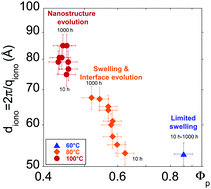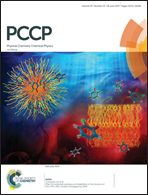Optimization of hydrophilic/hydrophobic phase separation in sPEEK membranes by hydrothermal treatments†
Abstract
Via SAXS, herein, we studied how a sPEEK microstructure evolves when it is immersed in water at a wide range of temperatures (20–100 °C) and time scales (from a few hours to dozens of days). In particular, we scrutinized the behavior of sPEEK at the temperature and time associated with the appearance of a well-defined nanosegregated morphology. At 80 °C, we observed nanoscale swelling along with smoothing of the water/polymer interface over a long period of time (several days). Herein, two of the main membrane properties, i.e., water uptake and proton conductivity, were studied for different immersion times and temperatures. It was found that the abovementioned properties were remarkably correlated with the evolution of the membrane microstructure, which was partly conserved after drying. The present findings helped us to understand that the thermally activated evolutions observed at both the nanoscale and macroscale were associated with the sPEEK β-relaxation crossover. Therefore, the very different swelling behaviors of sPEEK and Nafion are correlated to the much higher β-relaxation of sPEEK vs. Nafion (75 °C vs. −20 °C – dry state). From a practical viewpoint, this study emphasizes, for membranes alternative to Nafion, the importance and impact of the membrane pretreatment on their functional properties.



 Please wait while we load your content...
Please wait while we load your content...